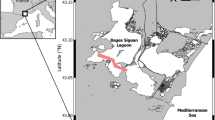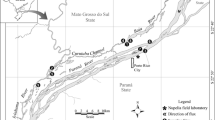Abstract
In temperate, marine waters on the lower west coast of Australia, Rhabdosargus sarba settles in unvegetated nearshore areas and then, as it increases in size, moves progressively to nearby seagrass beds and then to exposed unvegetated nearshore areas and finally to areas around reefs where spawning occurs. The von Bertalanffy growth curves fitted to the lengths at age of R. sarba collected from the different habitats mentioned above were significantly different from each other (P<0.001). These significant differences were at least partly attributable to the fact that the size-related movement of R. sarba between habitats affects the composition of the lengths at age of this species in each habitat. The problem of producing a sound quantitative description of the overall growth of the individuals in populations such, as that of R. sarba in coastal marine waters, was overcome by incorporating logistic functions within the von Bertalanffy growth model that accommodated the probability of a fish of a given length occurring in a particular habitat. R. sarba also underwent size-related changes in habitats in two other environments, namely a temperate estuary and a subtropical embayment. Thus, as this species increases in size, it moves from nearshore, shallow waters to offshore, deeper waters in the former environment and from mangroves to areas around reefs in the latter environment. Although descriptions of the growth of individuals in the populations of R. sarba in these latter two environments were improved statistically by using the adjusted von Bertalanffy growth equation, these improvements were so small that they were considered not to be of biological significance. This was because, in contrast to the situation in temperate coastal marine waters, the samples collected from the different habitats in the estuary and subtropical embayment provided, as a whole, better representations of the compositions of the lengths at age of those two populations. The growth of R. sarba was slightly faster in the lower reaches of the temperate estuary than in either temperate coastal marine waters or the subtropical marine embayment, where food was almost certainly less abundant.










Similar content being viewed by others
References
Cerrato RM (1990) Interpretable statistical tests for growth comparisons using parameters in the von Bertalanffy equation. Can J Fish Aquat Sci 47:1416–1426
El-Agamy AE (1989) Biology of Sparus sarba Forskål from the Qatari water, Arabian Gulf. J Mar Biol Assoc India 31:129–137
Fournier DA (1994) AUTODIF, a C++ array language extension with automatic differentiation for use in nonlinear modelling and statistics. Otter Research, Sidney, Canada
Garratt PA (1993) Comparative aspects of the reproductive biology of seabreams (Pisces: Sparidae), vol 1. PhD thesis, Rhodes University, Grahamstown
Hesp SA, Potter IC (2003) Reproductive biology of the tarwhine Rhabdosargus sarba (Sparidae) in three different environments on the west coast of Australia. J Mar Biol Assoc UK (in press)
Hesp SA, Potter IC, Hall NG (2002) Age and size composition, growth rate, reproductive biology, and habitats of the West Australian dhufish (Glaucosoma hebraicum) and their relevance to the management of this species. Fish Bull (Wash DC) 100:214–227
Hutchinson J, Moore L (1979) Cockburn Sound environment study 1976–1979. Report no. 2, Department of Conservation and Environment, Perth, Western Australia
Hyndes GA, Loneragan NR, Potter IC (1992) Influence of sectioning otoliths on marginal increment trends and age and growth estimates for the flathead Platycephalus speculator. Fish Bull (Wash DC) 90:276–284
Hyndes GA, Potter IC, Lenanton RCJ (1996) Habitat partitioning by whiting species (Sillaginidae) in coastal waters. Environ Biol Fishes 45:21–40
Kennish MJ (1990) Ecology of estuaries, vol II: biological aspects. CRC Press, Boca Raton, Fla.
Kuiter RH (1993) The complete diver’s and fishermen’s guide to coastal fishes of south-eastern Australia. Crawford, Bathurst, Australia
McNeill SE, Worthington DG, Ferrell DJ, Bell JD (1992) Consistently outstanding recruitment of five species of fish to a seagrass bed in Botany Bay, NSW. Aust J Ecol 17:359–365
Optimas (1995) OPTIMAS 5, user’s guide and technical reference, Vol 1, 7th edn. Optimas, Bothell, Wash.
Patnaik S (1973) Some aspects of the fishery and biology of the chilka Khuranti, Rhabdosargus sarba (Forskål). J Fish Soc India 5:102–114
Potter IC, Hyndes GA (1999) Characteristics of the ichthyofaunas of southwestern Australian estuaries, including comparisons with holarctic estuaries and estuaries elsewhere in temperate Australia: a review. Aust J Ecol 24:395–421
Radebe PV, Mann BQ, Beckley LE, Govender A (2001) Age and growth of Rhabdosargus sarba (Pisces: Sparidae), from KwaZulu-Natal, South Africa. Fish Res (Amst) 1333:1–9
Ricker WE (1969) Effects of size-selective mortality and sampling bias on estimates of growth, mortality, production and yield. J Fish Res Board Can 26:479–541
Ricker WE (1975) Growth rates and models. In: Hoar WS, Randall DJ, Brett JR (eds) Fish physiology, vol III. Bioenergetics and growth. Academic, New York, pp 687–743
Sarre GA, Potter IC (2000) Variation in age compositions and growth rates of Acanthopagrus butcheri (Sparidae) among estuaries: some possible contributing factors. Fish Bull (Wash DC) 98:785–799
Schelske CL, Odum EP (1961) Mechanisms maintaining high productivity in Georgia estuaries. Proc Gulf Caribb Fish Inst 14:75–80
Schnute J (1981) A versatile growth model with statistically stable parameters. Can J Fish Aquat Sci 38:1128–1140
Schnute JT, Richards LJ (1990) A unified approach to the analysis of fish growth, maturity, and survivorship data. Can J Fish Aquat Sci 47:24–40
Smith KA, Suthers IM (2000) Consistent timing of juvenile fish recruitment to seagrass beds within two Sydney estuaries. Mar Freshw Res 51:765–776
Travers MJ, Potter IC (2002) Factors influencing the characteristics of fish assemblages in a large subtropical marine embayment. J Fish Biol 61:764–784
Valesini FJ, Potter IC, Platell ME, Hyndes GA (1997) Ichthyofaunas of a temperate estuary and adjacent marine embayment. Implications regarding choice of nursery area and influence of environmental changes. Mar Biol 128:317–328
Van der Elst R (1988) A guide to the common sea fishes of southern Africa, 2nd edn. Struik, Cape Town
Wallace JH (1975) The estuarine fishes of the east coast of South Africa. III. Reproduction. Investigational report no. 41, South African Association for Marine Biological Research, Oceanographic Research Institute
Western Australia Environmental Protection Authority (1996) Southern metropolitan coastal waters study 1991–1994: summary report, November 1996. Department of Environmental Protection, Perth, Western Australia
White WT, Hall NG, Potter IC (2002) Size and age compositions and reproductive biology of the nervous shark Carcharhinus cautus in a large subtropical embayment, including an analysis of growth during pre- and postnatal life. Mar Biol 141:1153–1164
Yeung WSB, Chan STH (1987) The gonadal anatomy and sexual pattern of the protandrous sex-reversing fish, Rhabdosargus sarba (Teleostei: Sparidae). J Zool (Lond) 212:521–532
Acknowledgements
Our gratitude is expressed to colleagues at the Murdoch University Centre for Fish and Fisheries Research and R. Lopresti for help with sampling and to J. Chaplin for helpful comments. Financial support was provided by the Fisheries Research and Development Corporation, Fishcare, Western Australia, and Murdoch University. We declare that all procedures complied with the current Australian animal ethics requirements.
Author information
Authors and Affiliations
Corresponding author
Additional information
Communicated by G.F. Humphrey, Sydney
Rights and permissions
About this article
Cite this article
Hesp, S.A., Hall, N.G. & Potter, I.C. Size-related movements of Rhabdosargus sarba in three different environments and their influence on estimates of von Bertalanffy growth parameters. Marine Biology 144, 449–462 (2004). https://doi.org/10.1007/s00227-003-1217-2
Received:
Accepted:
Published:
Issue Date:
DOI: https://doi.org/10.1007/s00227-003-1217-2




